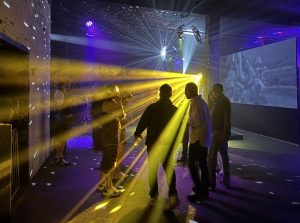The Museum of Life and Science in Durham, North Carolina is closed every Monday. But this Monday, a young man wearing a maroon “Life + Science” T-shirt perches outside of the entrance, waving down cars passing by, “The event is across the street.”
Across Murray Avenue, a circular patch of grass bordered by an asphalt walkway is wedged between another parking lot, a forest and the museum’s classroom buildings. It’s a sunny afternoon, so clear you could virtually count the wisps of clouds in the sky on one hand, and people are taking advantage of the weather, lying on the lawn on tartan blankets, packed into faded green picnic tables, or sitting in lawn chairs. It’s a little past 2 p.m. on April 8, 2024, and a crowd is gathering to view the solar eclipse.
***

“You’re a little chemist right now!” A volunteer with the Environmental Protection Agency (EPA) helps a little girl in a pink dress decorated with red, yellow, and blue sunglasses model water molecules using Legos. The museum has partnered with nature-focused community organizations to host this eclipse viewing. Black and silver strollers cluster around tables where volunteers from North Carolina Wildlife Federation and Keep Durham Beautiful lead interactive activities.
Every fall, monarch butterflies fly from Mexico to Canada. Today, the path of the total solar eclipse happens to follow suit, passing through Mexico and Texas, the Midwestern states, and up towards Ontario, Canada. So, across from the Legos, the North Carolina Wildlife Federation has a table covered in pictures of monarchs and other insects. At one table, attendees roll seeds and compostable paper scraps into “seed bombs” that will grow into sunflowers for monarch butterflies. Nearby, people are meeting one bug in-person: A group takes turns petting a giant Asian millipede that a little one affectionately starts to call “Pilly.”
***

The most popular table distributes what look like old 3D glasses, but with tinted lenses replacing the usual blue and red ones. The table runs out of the eclipse glasses quickly. By 3 p.m., the lawn is littered with sparkly crocs that had been kicked off in a hurry by little ones, metal water bottles, boxes of granola bars and multi-colored toy trucks, but not a single pair of the eclipse glasses.
“1…2…3,” one group grins for a picture with the glasses covering their eyes. A baby in a stroller plays with another pair. As he passes the glasses between his fists, soft sunlight reflects off the lenses and trails across his face. Another pair is plastered to the lens of a camera with several strips of blue masking tape. The camera sits on a tripod aimed at the sky, ready to preserve the moment.
Otherwise, the glasses cover faces pointed towards the sky. On the lawn, the little girl with the pink dress decorated with sunglasses lays on her back. She is wedged between a couple that looks like her, and the glasses are pulled over her eyes so she can stare directly at the sun.
Around 3:15 p.m., the eclipse peaks. “It’s the moon!” One boy points as his mother pulls the eclipse glasses across his face. Really, it’s the sun. But a black spot, the moon, obscures more than 70% of it, reducing the star to a toenail shape often associated with the moon.
As the moon moves across the sun, the world dims, as if the clear day were instead a glum, cloudy one. Attendees without glasses look down, peering through pinhole projectors made from shoe boxes, Amazon packages, and hole-punched pieces of paper in order to watch the eclipse indirectly.
But it’s not the same. The home-made projectors only recreate the eclipse. The real fun comes from being able to look directly into the sun, for once. You would have to wait 20 years, for the next eclipse, before you can once again ignore the usual admonitions against staring at the sun.
So those with glasses grin eagerly while staring intently for minutes at a time, like they might miss it. Then gradually, as the sun begins to re-emerge, they remove their glasses and approach strangers using boxes, packages and papers. One woman offers me her pair. “I was looking for you because I was thinking, ‘She doesn’t have glasses’,” she says. “Do you wanna see?”
Above: Photos by Kulsoom Rizavi — The 9th Street Journal






